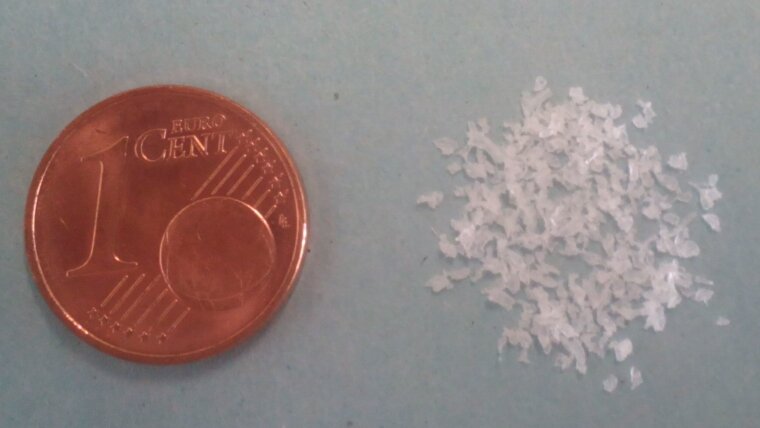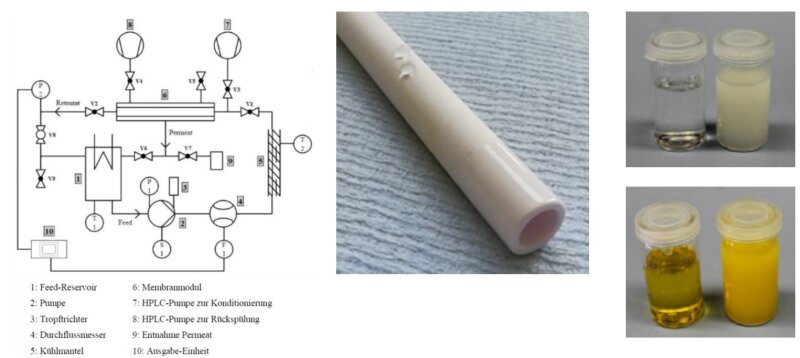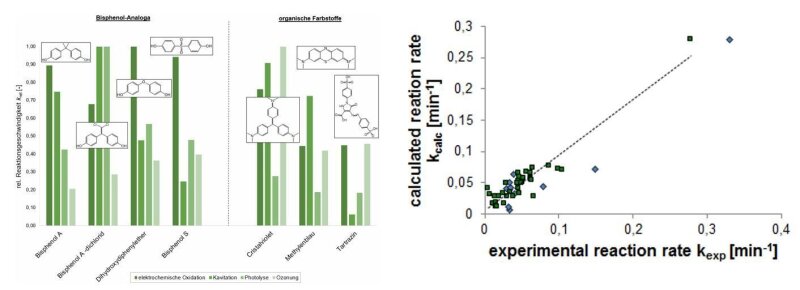
Advanced Oxidation Processes
In the research group different Advanced Oxidation Processes are investigated and (further) developed. This includes the use of acoustic and hydrodynamic cavitation, electrochemical processes, pyro- or piezoelectrocatalysis, photo(cat)lysis, Fenton reaction, hydrogen peroxide, ozonation and non-thermal plasma as well as their specific combination.
The detection and quantification of the reactive oxygen species formed is essential for the development of new or optimization of conventional advanced oxidation processes. For this purpose, different chemical dosimetries are used and further developed in the working area according to the specific application.
Detektion und Quantifizierung der reaktiven Hydroxylradikalkonzentration mit Hilfe der Salicylsäuredosimetrie (P. Braeutigam, Handbook of Ultrasonics and Sonochemistry, Springer, (2016))
Image: internIn the work area, the methods of pyro- and piezoelectric electrocatalysis are also being further developed. The aim is to use waste heat and / or sound as an initiator for the production of hydrogen and the oxidative removal of organic pollutants in water.
Pyroelektrokatalytische Wasserstoffproduktion sowie Oxidation unter Bildung eines Fluoreszenzfarbstoffes (J. Schlechtweg et.al, Phys. Chem. Chem. Phys., 2019, 21, 23009-23016, S. Raufeisen et al., Plos One, eingereicht)
Image: internA targeted combination of cavitation processes with other Advanced Oxidation Processes results in synergy effects based on physico-chemical effects during bubble collapse. Within the working area e.g. sonoelectrochemical and sonophotocatalytic processes as well as combinations of cavitation and ozonation are developed for different applications.
In addition to the development and optimization of appropriate reactor designs for different (combination) processes, aspects such as scale up and control are addressed and corresponding technical-economic analyses are performed.
Synergieeffekte bei der Kombination von Kavitation mit elektrochemischer Oxidation (links) und Ozonung (rechts) am Beispiel der Spurenstoffe Bisphenol A und Benzotriazol in Wasser sowie Abbildung eines Kombinationsreaktors (Mitte)
Image: internMembrane processes
In the working area, micro-, ultra- and nanofiltration with the aid of ceramic membranes are used, for example, to separate (mineral) oil-water emulsions such as cooling lubricant emulsions in the metalworking industry or to separate (micro-)pollutants from water. In addition to process optimization, the surface modification of the separating layer plays a central role. Typically, (perfluorinated) silanes are used for this purpose, which have various environmentally relevant, functional and economic problem areas. In the working group new environmentally friendly coatings were developed which are more stable and cheaper to the state of the art and can be obtained from renewable raw materials. Furthermore, these coatings can be used to integrate various functionalities such as surface polarity or heavy metal complexing.
R&I-Schema einer Membrantrennanlage, hydrophobierte tubulare Keramikmembran und Vergleich von feed und Permeat bei der Trennung von Kühlschmierstoff-Emulsionen bzw. bei der Wasserabtrennung von Ölen
Image: internAdsorption
For the removal of (micro-)pollutants, sorption processes are also investigated and (further) developed at the work area. The research focuses on the synthesis and characterization of carbon-based adsorber materials (e.g. graphene oxide) and the further development of the sorption process (e.g. ultrasound-assisted). In addition, surface-modified moulded bodies are developed as adsorbers and adsorber materials are immobilised on different carrier materials and integrated into corresponding modules.
R&I-Schema einer Festbettadsorption (links), modifizierter bzw. unmodifizierter keramischer Formkörper als Adsorbermaterial (Mitte) sowie Charakterisierung anhand von Sauerstoff-Gruppen (rechts)
Image: internSensor technology
The chemical oxygen demand (COD) is a sum parameter and can be found in numerous German and European laws and guidelines (AbwV, AbwAG, GrwV, OGewV, WRRL). It is suitable for the assessment and regulation of the totality of organic water pollutants. In addition, the COD has an important function as a control parameter in process optimization (energy savings, cost reduction) of municipal and industrial wastewater treatment plants as well as in biomass plants. Due to the many shortcomings of the dichromate method, a novel electrochemical measuring system is being developed in the working area, which combines the (sono-)electrochemical in-situ generated hydroxyl radicals and the amount of degraded organic (pollutant) substances in one measuring signal (e.g. current intensity, voltage). In addition to the further development of the continuously operating, chemical-free and sustainable measuring method and design, the focus is particularly on extending the linear working range and reducing the detection limit. Further approaches can be found in the improvement of the TOC measurement.
Elektrochemische Messzelle zur kontinuierlichen Bestimmung des CSB (links), Messsignal (Mitte links), Zusammenhang von Messsignal und CSB (Mitte rechts) sowie der Einfluss des Ultraschalleintrages auf das Messsignal der Messzelle (rechts)
Image: internQSPR (Quantitative Structure Property Relationship) for advanced oxidation processes
In mining methods, the rate of extraction and mineralizability depends strongly on the chemical structure and the method used. Previous approaches tend to follow a trial-and-error approach to remove micropollutants as quickly and efficiently as possible. In this respect, a new approach is being pursued at the research unit - a coupling of chemical structure and the respective standardized mining method as well as the development of a predictive model. In particular, this approach makes it possible to predict the degradability of a compound based on its known chemical structure (structural formula or specific molecular structures or functional groups) using various methods, e.g. from the field of advanced oxidation processes. For this purpose, structural elements and molecular descriptors describing the molecule are linked via methods of artificial intelligence and machine learning to the real measured chemical behaviour and reaction kinetics of a large number of real measured samples (test data set). With the help of such a (universal) predictive model, the degradation behaviour of even new, as yet unknown substances can be predicted, including optimised proposals for the type and operating parameters of the AOP processes that can be used. With such models and data it is also possible to determine design criteria for the reactors to be provided in the water treatment technology. In addition, the model also allows the possibility - e.g. for environmental authorities - to recommend alternatives for chemicals used so far, which lead to low environmental impacts under the regionally predominant treatment technologies. A corresponding high-thoughput system for generating large amounts of data is also available.
Übersicht und Ranking der kinetischen Konstanten für den Abbau mit unterschiedlichen AOPs (links) und Vergleich der experimentell bestimmten Geschwindigkeitskonstanten mit der über das Modell berechnete Geschwindigkeitskonstanten am Beispiel von Bisphenol-Analoga (rechts)
Image: internAnthropogenic micropollutants
Anthropogenic micropollutants in the hydrological cycle are increasingly attracting scientific and social interest. The compounds occurring in water in concentrations ranging from a few ng/L to µg/L include, for example, residues of pharmaceuticals or industrial chemicals. The detection and quantification of these as well as the transformation products resulting from oxidative/reductive treatment processes is part of the research of the department. Furthermore, the oxidative/reductive degradation of pollutants in water takes place via different paths and several intermediate steps, forming various transformation products. The composition and temporal development of the concentrations of these compounds is of importance for the ecotoxicity as well as for the design of corresponding processes. Knowledge of the degradation mechanisms and kinetics is relevant for this.
Transformationsprodukte bei oxidativen Abbau von Carbamazepin (links), Zeitlicher Verlauf der Edukt/Transformations-produkt-Konzentrationen beim Abbau von Carbamazepin (Mitte) und Initialschritt beim Hydroxylradikal-induzierten Abbau von Carbamazepin (rechts) (P. Braeutigam et al., Water Research, 46, 2469, (2012)
Image: internMicro plastics
Microplastics are directly (primary microplastics) or indirectly (secondary microplastics) introduced into the water cycle via various degradation mechanisms of macroscopic plastics. Microplastics comprise plastic particles of a size of < 5 mm. The influence of different ageing effects (photochemical, mechanical) on the sorption behaviour of (aged) polymers with respect to different micropollutants (polarity, size) as well as the release of different components of the polymers is part of the research group's investigations.
Einfluss der Polarität auf das Sorptionsverhalten von Mikroschadstoffen an Mikroplastik am Beispiel des HDPE (links), Umweltmikroplastik (Mitte) und Einfluss der Alterung auf das Sorptionsverhalten von Diphenylamin an HDPE (rechts)
Image: internRecyclable material recovery from waste water
The recovery of various valuable substances from municipal and industrial waste water is part of the research. For example, research is being conducted into capacitive deionisation for the removal and/or recovery of phosphates and nitrates. Furthermore, the recovery and recycling of ingredients from cooling lubricants or the use of oils from previously digested (micro-)algae for various applications is being investigated.








